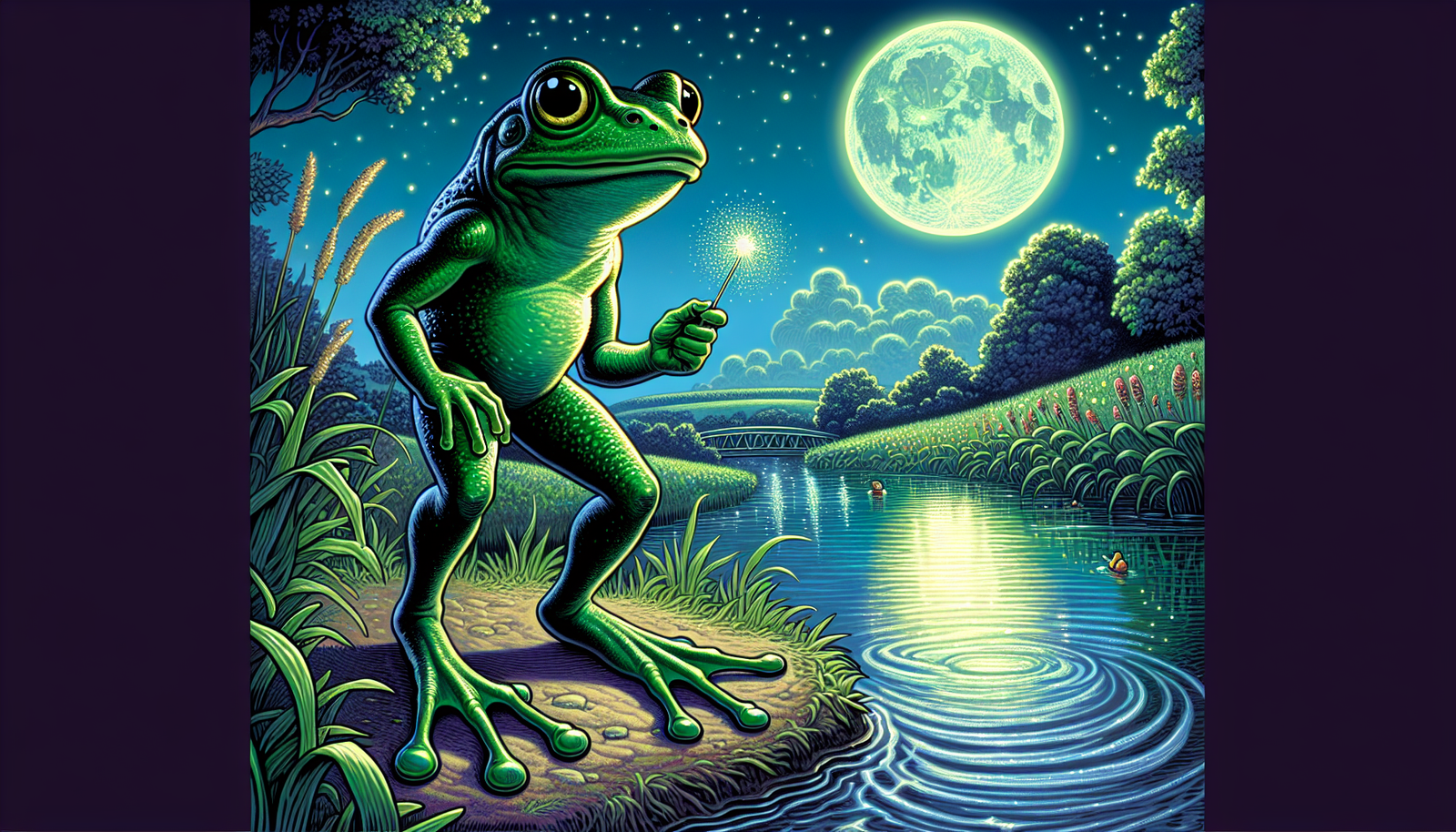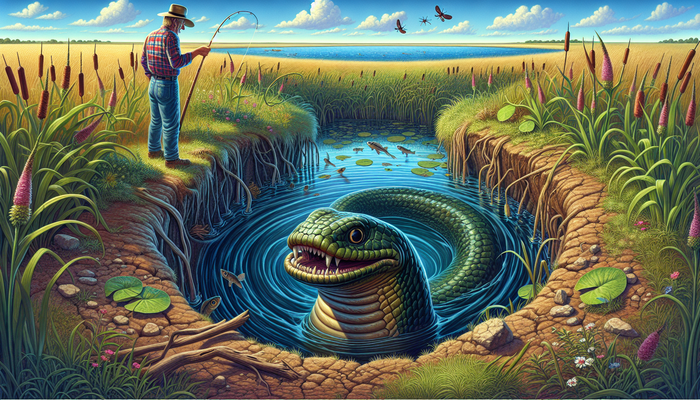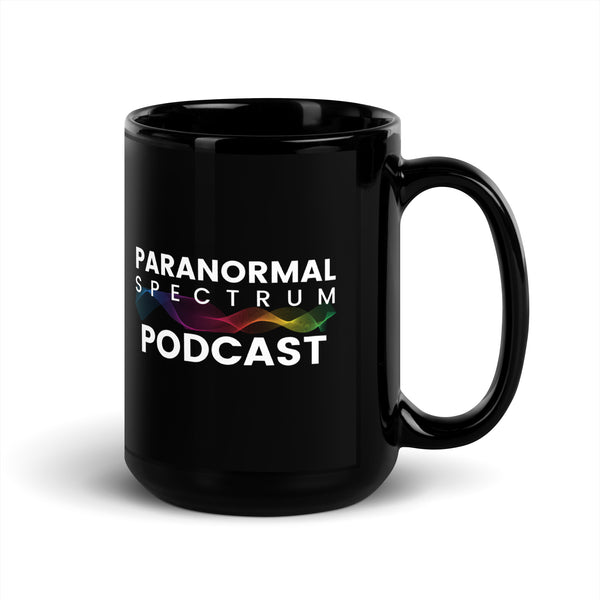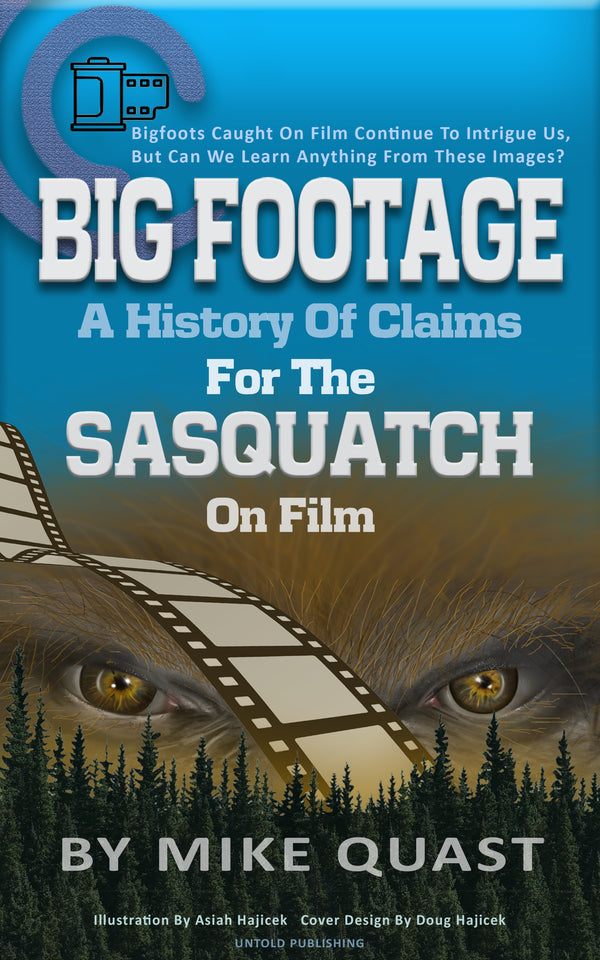The Frog Man: Uncovering the Legend and Art Behind the Myth

By Jack Sullivan, Cryptozoologist
The Loveland Frogman: A Cryptid's Tale
It's a warm May night in 1955. A businessman is driving along a lonely road near the Little Miami River in Loveland, Ohio. Suddenly, his headlights illuminate something impossible - three bipedal creatures, each about four feet tall, with leathery skin and frog-like faces. One of them raises what looks like a wand, showering sparks into the night air. In that moment, the legend of the Loveland Frogman was born.
This first sighting set the stage for a cryptid that would become as much a part of Loveland as the river itself. The description was vivid and strange: a creature that stood upright like a human but had the unmistakable features of a frog, complete with webbed hands and feet. It was as if someone had taken a frog and stretched it into human proportions, creating a being that straddled the line between the familiar and the fantastical.
But the story didn't end there. The Loveland Frogman decided to make another appearance, this time to an audience that would lend credibility to the tale. On March 3, 1972, at the witching hour of 1:00 AM, Officer Ray Shockey was on patrol near the Totes boot factory when he saw something scurry across the road. His police training kicked in, and he observed the creature with a keen eye. What he saw matched the description from 1955: a 3 to 4-foot-long animal, weighing about 50 to 75 pounds, with leathery skin. Officer Shockey reported that it was "crouched like a frog" before it stood up, climbed over a guardrail, and disappeared towards the river.
Just when you think the story couldn't get any wilder, enter Officer Mark Matthews. Two weeks after Shockey's encounter, Matthews spotted what he thought was an injured animal on the road. Being the good officer he was, he decided to remove it from harm's way. But as he approached, the creature sprang to life, revealing a face that was decidedly un-roadkill-like. Matthews, startled but quick on the draw, shot at the creature. The animal managed to escape over the guardrail, but not before giving Matthews a good look at its reptilian features.
Now, here's where the story takes an unexpected turn. Years later, Matthews came forward with a revelation that would shake the foundations of the Loveland Frogman legend. He claimed that what he shot wasn't a cryptid at all, but a large iguana missing its tail. Matthews speculated it was an escaped or released pet, drawn to the warmth of the nearby boot factory in the chilly Ohio spring.
This revelation sparked a heated debate in the cryptozoology community. Was the Loveland Frogman nothing more than an overgrown lizard with a knack for dramatic appearances? Or was there more to the story that even Matthews didn't fully understand?
Despite the iguana theory, the legend of the Loveland Frogman refused to croak. In 2016, the creature made headlines again when a couple playing Pokémon Go claimed to have spotted it near Lake Isabella. They even snapped some photos, though the images were too dark and blurry to be conclusive. This modern sighting reignited interest in the legend, proving that even in the age of smartphones and augmented reality games, there's still room for a little mystery in the world.
Cultural Impact of the Loveland Frogman
The Loveland Frogman has become more than just a local legend; it's a cultural icon. The city of Loveland has embraced its amphibious celebrity, featuring the creature in local art, merchandise, and even naming it as the official city mascot in 2023. The frogman, dressed as a "frog prince," now makes appearances at city events, bringing a touch of whimsy to local celebrations.
But perhaps the most spectacular tribute to the Loveland Frogman came in the form of a musical. In May 2014, "Hot Damn! It's the Loveland Frog!" premiered at the Cincinnati Fringe Festival. This bluegrass musical brought the legend to life on stage, combining local lore with foot-stomping tunes. It's not every day that a cryptid gets its own musical number, but then again, the Loveland Frogman isn't your average monster.
The legend has also inspired authors and filmmakers. James Renner's science fiction mystery novel, "The Man From Primrose Lane," features a version of the Loveland Frogman, weaving the local legend into a complex narrative. In 2024, the found footage horror film "Frogman" hit screens, bringing the cryptid into the realm of modern cinema.
The Enduring Appeal of the Loveland Frogman
What makes the Loveland Frogman so enduring? Perhaps it's the blend of the familiar and the fantastic. Frogs are common enough in Ohio, but a frog that stands upright and wields a sparking wand? That's the stuff of fairy tales. Or maybe it's the way the legend has evolved over time, adapting to new media and new generations of storytellers.
University of Cincinnati folklore professor Edgar Slotkin draws an interesting parallel, comparing the Loveland Frogman to Paul Bunyan. Both are larger-than-life figures that capture something essential about the places they're from. Just as Paul Bunyan embodies the spirit of the American frontier, the Loveland Frogman represents something uniquely Ohioan - a mix of rural mystery and suburban legend.
The Loveland Frogman isn't just a story; it's a community bonding experience. The annual Frogman Festival brings together believers, skeptics, and the simply curious. It's a celebration of local lore, complete with frogman-themed games, storytelling sessions, and even "frog juice" for the adventurous. The festival has become a tourist draw, bringing visitors from across the country to this small Ohio town.
But the Loveland Frogman's influence extends beyond just tourism. It's become a way for the community to connect with its history and natural environment. The legend encourages people to explore the Little Miami River and the surrounding wilderness, fostering an appreciation for local ecosystems. After all, if you're looking for a frogman, you're going to encounter a lot of actual frogs along the way.
The legend also serves as a reminder of the power of storytelling. In an age of instant information and digital entertainment, the Loveland Frogman represents a more traditional form of community narrative. It's a story passed down through generations, changing and growing with each retelling. Whether you believe in the frogman or not, there's something magical about a tale that can capture the imagination of an entire town for decades.
Tim Cotterill: The Frogman of Art
Tim Cotterill's journey to becoming "The Frogman" is as colorful as his sculptures. Born in Leicester, England, in 1950, Cotterill grew up with a love for nature that would later define his artistic career. As a boy, he spent countless hours exploring the English countryside, fascinated by the creatures he encountered. Little did he know that those childhood adventures would one day inspire a global art phenomenon.
Cotterill's path to artistic success was anything but straightforward. He began his career not as an artist, but as an engineer. For six years, he apprenticed in the field, honing skills that would later prove invaluable in his sculptural work. This blend of technical knowledge and artistic vision is what sets Cotterill's work apart.
In the 1970s and 1980s, Cotterill began experimenting with metal sculptures, creating birds and animals out of steel, bronze, and gold. His early works caught the eye of collectors, and some even found their way to Sotheby's auction house. But it wasn't until Cotterill moved to Venice Beach, California, in 1990 that he found his true calling.
It was in the vibrant, eclectic atmosphere of Venice Beach that Cotterill's frog sculptures were born. Inspired by the playful spirit of his new home and drawing on his childhood memories of frogs in English ponds, Cotterill began crafting whimsical bronze amphibians. These weren't just any frogs; they were full of personality, each one seeming to tell its own story.
The Art of Frog-Making
Cotterill's process is as fascinating as the end result. It begins with a wire frame, onto which he builds the frog's form using car body filler. He meticulously shapes and sands the sculpture until it's just right. Then, it's off to the foundry where the magic of lost-wax casting brings the frog to life in bronze.
But what truly sets Cotterill's frogs apart is the patina. Using a variety of chemicals and techniques, Cotterill creates vibrant, jewel-like finishes that make each frog a unique work of art. From iridescent greens to rich golds and deep blues, the colors bring these bronze amphibians to life in a way that's simply captivating.
Cotterill's frogs aren't just static sculptures; they're full of movement and expression. Some appear to be mid-leap, capturing the dynamic energy of a frog in motion. Others are more contemplative, perhaps basking in the sun or watching for flies. There are frogs that seem to dance, frogs that stretch languorously, and frogs that look like they're about to strike up a conversation.
What's remarkable about Cotterill's work is how he manages to imbue each frog with distinct personality traits. There's the "prince charming" frog, all debonair and dashing. Then there's the mischievous trickster, with a glint in its eye that suggests it's up to no good. Some frogs appear wise and ancient, while others have a youthful, playful energy.
The Impact of Cotterill's Frogs
This ability to create such expressive creatures out of cold metal is what has made Cotterill one of the best-selling bronze sculptors in the world. His frogs have found homes in galleries and private collections across the globe, from small town America to the far reaches of Asia and Europe.
But Cotterill's success isn't just about technical skill or marketing savvy. There's something about his frogs that resonates on a deeper level with people. Perhaps it's the way they remind us of the joy and wonder we felt as children, discovering nature for the first time. Or maybe it's the way they bring a touch of whimsy and humor into our often-serious adult lives.
Collectors often speak of the emotional connection they feel to Cotterill's frogs. Many report that having a Frogman sculpture in their home brings a daily dose of joy and laughter. It's not uncommon for people to build entire collections, each frog holding a special place in their hearts.
Cotterill's work has also had a significant impact on the art world. He's shown that sculpture can be both technically impressive and accessible, bridging the gap between fine art and popular culture. His success has paved the way for other artists working in similar whimsical, nature-inspired styles.
Moreover, Cotterill's frogs have become more than just art objects; they're a cultural phenomenon. Frogman collectors' clubs have sprung up around the world, bringing together people who share a love for these quirky creatures. Cotterill himself often attends gallery events, signing pieces and meeting fans, further strengthening the connection between artist and audience.
But perhaps the most important aspect of Cotterill's work is how it's changed people's perceptions of frogs themselves. Through his art, Cotterill has highlighted the beauty, diversity, and charm of these amphibians. In an age where many frog species are threatened by habitat loss and climate change, Cotterill's sculptures serve as colorful ambassadors for frog conservation.
The Intersection of Art and Folklore
At first glance, the Loveland Frogman and Tim Cotterill's bronze frogs might seem worlds apart. One is a mysterious cryptid, the subject of whispered tales and late-night sightings. The other is a celebrated art form, displayed proudly in homes and galleries. Yet, when we look closer, we see that these two frog-inspired phenomena share some fascinating common ground.
Both the Loveland Frogman and Cotterill's sculptures tap into our deep-seated fascination with the natural world, particularly the mysterious and often overlooked realm of amphibians. Frogs have long held a special place in human culture, appearing in myths and fairy tales around the world. They're creatures of transformation, bridging the gap between water and land, tadpole and adult. This liminal quality makes them perfect subjects for both cryptid lore and artistic expression.
The element of whimsy is another shared trait. The Loveland Frogman, despite its sometimes frightening descriptions, has a certain absurdist charm. A frog-faced creature wielding a sparking wand? It's as much Lewis Carroll as it is horror story. Similarly, Cotterill's frogs, with their exaggerated poses and expressive faces, invite us to see the humor and joy in nature.
Both phenomena also serve as powerful community builders. The Loveland Frogman has become a rallying point for the town of Loveland, a shared story that brings people together. It's spawned festivals, inspired local businesses, and given the town a unique identity. In much the same way, Cotterill's frogs have created a global community of collectors and admirers. People who might otherwise have little in common find themselves bonding over their shared love of these whimsical sculptures.
Reality and Imagination
There's also an interesting interplay between reality and imagination in both cases. The Loveland Frogman exists in that tantalizing space between the possible and the impossible. Is it real? Is it a misidentified known animal? Or is it purely a product of human imagination? This ambiguity is part of its appeal. Cotterill's frogs, while clearly art objects, blur the line between reality and fantasy in their own way. They're anatomically recognizable as frogs, yet their poses and expressions push them into the realm of the fantastical.
Both the cryptid and the art frogs also serve as gateways to deeper engagement with nature. The Loveland Frogman legend encourages people to explore the Little Miami River and its surroundings, fostering an appreciation for local ecosystems. Cotterill's sculptures, with their celebration of frog diversity, inspire people to learn more about real frogs and their conservation needs.
The Power of Storytelling
In a broader sense, both the Loveland Frogman and Cotterill's sculptures represent the enduring power of storytelling in human culture. The Loveland Frogman is a modern myth, a story that evolves with each retelling, adapting to new media and new generations. Cotterill's frogs, while static objects, invite viewers to imagine stories around them. Each sculpture seems to capture a moment in an untold narrative, encouraging the viewer to fill in the before and after.
This storytelling aspect points to a deeper truth about human nature. We are, at our core, storytelling animals. We use narratives to make sense of the world around us, to build communities, and to express our hopes and fears. Whether it's a tale of a mysterious creature lurking in the Ohio woods or the story we imagine around a bronze frog frozen mid-leap, these narratives enrich our lives and connect us to each other.
Changing Attitudes Towards Nature
The Loveland Frogman and Cotterill's sculptures also reflect changing attitudes towards nature in modern society. In an increasingly urbanized world, both serve as reminders of our connection to the natural world. The Loveland Frogman represents the wild, untamed aspects of nature that still exist on the fringes of our cities and towns. Cotterill's frogs, on the other hand, bring a touch of that wild nature into our homes and everyday lives.
There's also an interesting economic angle to consider. Both the Loveland Frogman and Cotterill's frogs have become significant drivers of local economies. The Loveland Frogman attracts tourists, supports local businesses, and has even inspired its own line of merchandise. Cotterill's sculptures have created a thriving market, supporting not just the artist himself but also galleries, foundries, and various ancillary businesses.
A New Perspective
In the end, perhaps the most significant commonality between the Loveland Frogman and Cotterill's sculptures is how they encourage us to see the world differently. The Loveland Frogman invites us to consider that there might be more to our familiar surroundings than meets the eye, that mystery and wonder can exist right in our backyards. Cotterill's frogs challenge us to look at a common animal in a new light, to see the beauty, personality, and yes, even the humanity, in a creature we might otherwise overlook.
Both also speak to our need for magic in the modern world. In an age of science and technology, where so much of the world has been explained and catalogued, both the Loveland Frogman and Cotterill's frogs offer a touch of the inexplicable, the whimsical, the magical. They remind us that there's still room for wonder and imagination in our lives.
As we've seen, the frog man, whether as cryptid or bronze sculpture, is far more than just a curiosity. It's a cultural touchstone, a community builder, an economic driver, and a bridge between humanity and nature. From the mist-shrouded banks of the Little Miami River to the sun-drenched galleries of California, the frog man continues to captivate our imagination and challenge our perceptions.
The enduring popularity of both the Loveland Frogman and Cotterill's sculptures suggests that our fascination with these amphibious entities is far from over. As we face increasing environmental challenges and a world that often seems to prioritize the digital over the natural, perhaps we need these frog men more than ever. They remind us of the magic that exists in the natural world, the power of storytelling to build communities, and the importance of maintaining our sense of wonder.
Whether you're a skeptic or a believer, an art collector or a folklore enthusiast, there's something in the world of the frog man for everyone. So the next time you're near a pond or river, take a moment to look closely. You never know - you might spot a Loveland Frogman lurking in the shadows, or find inspiration for your very own Cotterill-esque frog pose. After all, in the world of the frog man, the ordinary can become extraordinary in the blink of an eye - or the splash of a webbed foot.
From Bigfoot to UFOs: Hangar 1 Publishing Has You Covered!
Explore Untold Stories: Venture into the world of UFOs, cryptids, Bigfoot, and beyond. Every story is a journey into the extraordinary.
Immersive Book Technology: Experience real videos, sights, and sounds within our books. Its not just reading; its an adventure.



























